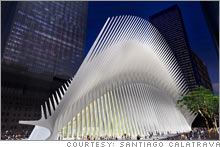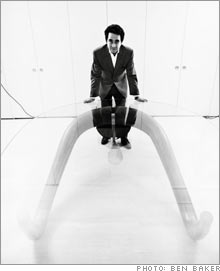Building bridges, skyscrapers and Ground ZeroSantiago Calatrava may be the most influential architect of our time. He talks to Fortune's Julie Schlosser about rebuilding Ground Zero, the importance of light and what makes him an optimist.(Fortune Magazine) -- Over the past three decades, Santiago Calatrava has built more than 40 structures, ranging from bridges to train stations to museums. His best work has an emotional resonance rarely found in modern buildings, a power that lifts the greatest contemporary architecture from the structural to the sublime. In America, Calatrava is just beginning to make his mark. He is working on several projects in the U.S., including a transportation hub at Ground Zero and a 115-story building in Chicago, which, if built, will be the country's tallest building.
Where is architecture today, and where is it going? The beginning of the 21st century is very different from the 20th century. We've grown into a mass culture. The media plays an enormous role in design. The other influence is a social one. We've grown into a population of billions who need to be fed, transported and taken care of. In the Third World you see macro-cities that are out of control. There's the need to give houses and food to millions in places like Calcutta. These two phenomena will be key to understanding architectural design. It is much easier to read a paper than to build a house. The media are omnipresent; design is not. Creating a high-speed train to connect those cities together is much more difficult than reaching them through the media. So communications and the necessity we have to deliver on these problems will be fundamental going forward. There seem to be two major schools of architecture these days: one with an eye on development and environmental issues, the other with more of an artistic flair, which would include you and Frank Gehry. Will the two schools ever merge? Personally, I have been involved in many public projects - train stations, schools or educational buildings and structures that serve towns and impact millions. I have also built many bridges for transportation. My private work is touched by this destiny of understanding that architecture and engineering have a social character and can serve the community. Around 90 percent of my work is like that. People are grateful for these - not only for having the structures for functional purposes but because it is done with beauty and dignity. It is very important to deliver a sign of beauty to show that someone is paying attention. That means that not only does the train work, but it also works in a beautiful manner. People don't only need bread. They need bread given to them with care. It is sometimes just as important to focus on how you serve it. You made your name by building bridges. There are 20 finished so far and several more in the works. Why bridges? A bridge is born of necessity, but it must establish its own identity. It should harmonize with its surroundings, and the design must transcend the purely local and transform the setting. Building a bridge, in my opinion, is a symbolic gesture, linked with the needs of people who cross over it, and with the idea of overcoming or surmounting obstacles. A modern bridge can also be a work of art. It helps to shape our daily lives and becomes a vital experience for all the people who use it. Which bridge are you proudest of? The Alamillo Bridge [in Seville, Spain], because it was the first of its kind, and the one in Redding, Calif. [known as the Sundial Bridge at Turtle Bay]. It's an extraordinary site. I loved doing it. Your designs require the use of modern technology to make such dynamic structures. I am an engineer, not just an architect, so I've always been motivated by technique or technology. As soon as technology moves just a little bit, it changes architecture. There is progress. The computer has signified an enormous revolution. You can go to a more sophisticated geometry and you can also communicate with the industry. The technique is not only important in my work but also important for the person who will execute the building process. We can communicate with each other and deliver in an easier way. So, starting with the work of architect and going through production, it changes things. You've said that your favorite material is light. Yes. The reason is for comfort. Comfort in our time is different. It isn't the same sense as it was years ago. A big meal no longer means comfort. Comfort by eating doesn't mean quantity today; it means quality. Just two generations ago it was different. You'd eat four or five courses. The more courses, the better. In my opinion, comfort in architecture is given by two words. One is "space." The other is "light." Narrow or small spaces are not as good. Less light, underground spaces, spaces where you don't see the sky, [are] not as good. These are the two keys to the future. I am always searching for more light and space. Wide spaces are what I am using at Ground Zero. I believe that architects need to deliver hope and optimism. It is part of our duty. How have the attacks on 9/11 affected the profession? We are just a few years from it, but we see already an enormous consequence. You would think people would stop building high skyscrapers. But the opposite has occurred. Skyscrapers have become more powerful, more meaningful. Another significance is that we believe in our time, we believe in our culture. New York, in my eyes, was a young, very vital city. But suddenly with Sept. 11, after an enormous tragedy happens, things change. Suddenly New York is no longer a young city. It plays in another league now, like Athens, Rome, Jerusalem. A city that has been burned down and rebuilt. New York now has this depth. It is not the same thing to build here as it was before. It is like building in Jerusalem. Your Ground Zero project - a transportation hub that connects the city through an artery of underground trains - is developing with little controversy. You came in with your plan and broke ground earlier this year. That seems rare at Ground Zero and in building in general. How did you do that? It is nothing to do with me. It is a merit of my client, the Port Authority. The Port Authority is a very experienced body in construction. It has built many great buildings - Saarinen's TWA terminal, the Twin Towers, etc. You're being modest. There's been so much fighting around the towers. Yet you come in and build without a fuss. I don't think I am modest. I didn't have to teach the builders much. They know so much already. In a silent way there was a momentum in the Port Authority. They never say it to me, but they lost around 85 people. Could you imagine? I gained an enormous respect for these people. An architect from abroad has nothing to do with this. [My job] is not to teach [them] to build. It is to show what is possible. Do you think what the public witnessed at Ground Zero over the past five years - fighting between architects, developers, and politicians - will hurt the profession? No. Because, you see, people are anxious to see buildings. People want to see things happening. You have to remember that these projects sometimes take years. I am working on a project in my home town, Valencia [on the east coast of Spain], and it has been in progress for 16 years. You have to have endurance in this profession. You start a project as a young person and then at the end you are another person. You are ready to go for your pension. I don't know of anyone who can make something in two to three years. We are spoiled. We think we should get things so fast. You've designed what could become the tallest building in the U.S. How is it going? We are starting to build in March. We have a 37-month program. The location is inspiring. It is close to Lake Michigan, at the end of the Chicago River. Chicago is the first modern city to realize the importance of architecture. Moreso, I think, than New York. You are working on a plan with developer Frank Sciame to build a residential tower at South Street Seaport near Ground Zero. You haven't broken ground on the 835-foot tower. Will it be built? It is a dream that I hope I can realize. It is one of the most beautiful things I've ever done. I have a wonderful client, and I hope we can build it. It is a wonderful location. He wants to do something different. He wants to deliver something very special. We are very close, and I am full of hope we will start it. What are your favorite buildings? The Parthenon [Athens], Hagia Sophia [the Byzantine church that later became a mosque in Istanbul], the Chrysler Building [New York City], Grand Central Terminal [New York City], and Amiens Cathedral [Amiens, France]. ____________________ |
|



